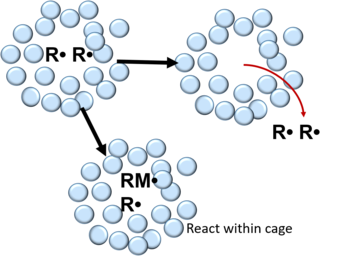Cage effect

In chemistry, the cage effect[1] (also known as geminate recombination[2]) describes how the properties of a molecule are affected by its surroundings. First introduced by James Franck and Eugene Rabinowitch[3][4] in 1934, the cage effect suggests that instead of acting as an individual particle, molecules in solvent are more accurately described as an encapsulated particle. The encapsulated molecules or radicals are called cage pairs or geminate pairs.[5][6] In order to interact with other molecules, the caged particle must diffuse from its solvent cage. The typical lifetime of a solvent cage is 10-11 seconds.[7] Many manifestations of the cage effect exist.[8]
In free radical polymerization, radicals formed from the decomposition of an initiator molecule are surrounded by a cage consisting of solvent and/or monomer molecules.[6] Within the cage, the free radicals undergo many collisions leading to their recombination or mutual deactivation.[5][6][9] This can be described by the following reaction:
After recombination, free radicals can either react with monomer molecules within the cage walls or diffuse out of the cage. In polymers, the probability of a free radical pair to escape recombination in the cage is 0.1 – 0.01 and 0.3-0.8 in liquids.[5] In unimolecular chemistry, geminate recombination has first been studied in the solution phase using iodine molecules[10] and heme proteins.[11][12] In the solid state, geminate recombination has been demonstrated with small molecules trapped in noble gas solid matrices[13] and in triiodide crystalline compounds.[14][15][16]
Cage recombination efficiency
The cage effect can be quantitatively described as the cage recombination efficiency Fc where:
Here Fc is defined as the ratio of the rate constant for cage recombination (kc) to the sum of the rate constants for all cage processes.[9] According to mathematical models, Fc is dependent on changes on several parameters including radical size, shape, and solvent viscosity.[9][17][18] It is reported that the cage effect will increase with an increase in radical size and a decrease in radical mass.
Initiator efficiency
In free radical polymerization, the rate of initiation is dependent on how effective the initiator is.[6] Low initiator efficiency, ƒ, is largely attributed to the cage effect. The rate of initiation is described as:
where Ri is the rate of initiation, kd is the rate constant for initiator dissociation, [I] is the initial concentration of initiator. Initiator efficiency represents the fraction of primary radicals R·, that actually contribute to chain initiation. Due to the cage effect, free radicals can undergo mutual deactivation which produces stable products instead of initiating propagation – reducing the value of ƒ.[6]
See also
References
- ^ Chemistry (IUPAC), The International Union of Pure and Applied. "IUPAC - cage effect (C00771)". goldbook.iupac.org. doi:10.1351/goldbook.c00771. Retrieved 2022-03-28.
- ^ Chemistry (IUPAC), The International Union of Pure and Applied. "IUPAC - geminate recombination (G02603)". goldbook.iupac.org. Retrieved 2022-03-28.
- ^ Rabinowitch, Franck (1934). "Some remarks about free radicals and the photochemisty of solutions". Transactions of the Faraday Society. 30: 120–130. doi:10.1039/tf9343000120.
- ^ Rabinowitch, E (1936). "The collison [sic] mechanism and the primary photochemical process in solutions". Transactions of the Faraday Society. 32: 1381–1387. doi:10.1039/tf9363201381.
- ^ a b c Denisov, E.T. (1984). "Cage effects in a polymer matrix". Macromolecular Chemistry and Physics. 8: 63–78. doi:10.1002/macp.1984.020081984106.
- ^ a b c d e f Chanda, Manas (2013). Introduction to Polymer Science and Chemistry: A problem solving approach. New York: CRC Press. pp. 291, 301–303.
- ^ Herk, L.; Feld, M.; Szwarc, M. (1961). "Studies of "Cage" Reactions". J. Am. Chem. Soc. 83 (14): 2998–3005. doi:10.1021/ja01475a005.
- ^ "Radical cage effects" (PDF).
- ^ a b c d e Braden, Dale, A. (2001). "Solvent cage effects. I. Effect of radical mass and size on radical cage pair recombination efficiency. II. Is geminate recombination of polar radicals sensitive to solvent polarity?". Coordination Chemistry Reviews. 211: 279–294. doi:10.1016/s0010-8545(00)00287-3.
{{cite journal}}: CS1 maint: multiple names: authors list (link) - ^ Schwartz, Benjamin J.; King, Jason C.; Harris, Charles B. (1994), Simon, John D. (ed.), "The Molecular Basis of Solvent Caging", Ultrafast Dynamics of Chemical Systems, Dordrecht: Springer Netherlands, pp. 235–248, doi:10.1007/978-94-011-0916-1_8, ISBN 978-94-011-0916-1, retrieved 2022-03-28
- ^ Chernoff, D A; Hochstrasser, R M; Steele, A W (1980-10-01). "Geminate recombination of O2 and hemoglobin". Proceedings of the National Academy of Sciences. 77 (10): 5606–5610. doi:10.1073/pnas.77.10.5606. ISSN 0027-8424. PMC 350115. PMID 6932659.
- ^ Rohlfs, R J; Olson, J S; Gibson, Q H (1988-02-05). "A comparison of the geminate recombination kinetics of several monomeric heme proteins". Journal of Biological Chemistry. 263 (4): 1803–1813. doi:10.1016/s0021-9258(19)77948-4. ISSN 0021-9258. PMID 3338995.
- ^ Apkarian, V. A.; Schwentner, N. (1999-06-09). "Molecular Photodynamics in Rare Gas Solids". Chemical Reviews. 99 (6): 1481–1514. doi:10.1021/cr9404609. ISSN 0009-2665. PMID 11849000.
- ^ Cerullo, Giulio; Garavelli, Marco (2017-05-27). "Caught in the act". Nature Chemistry. 9 (6): 506–507. doi:10.1038/nchem.2780. ISSN 1755-4349. PMID 28537591.
- ^ Poulin, Peter R.; Nelson, Keith A. (2006-09-22). "Irreversible Organic Crystalline Chemistry Monitored in Real Time". Science. 313 (5794): 1756–1760. doi:10.1126/science.1127826. PMID 16946037. S2CID 35002522.
- ^ Xian, Rui; Corthey, Gastón; Rogers, David M.; Morrison, Carole A.; Prokhorenko, Valentyn I.; Hayes, Stuart A.; Miller, R. J. Dwayne (2017-03-27). "Coherent ultrafast lattice-directed reaction dynamics of triiodide anion photodissociation". Nature Chemistry. 9 (6): 516–522. doi:10.1038/nchem.2751. hdl:20.500.11820/52dbea74-99b4-454b-aac2-56c7be20947b. ISSN 1755-4349. PMID 28537597.
- ^ Noyes, R.M. (1954). "A Treatment of Chemical Kinetics with Special Applicability to Diffusion Controlled Reactions". J. Chem. Phys. 22 (8): 1349–1359. Bibcode:1954JChPh..22.1349N. doi:10.1063/1.1740394.
- ^ Noyes, R.M. (1961). "Effects of diffusion rates on chemical kinetics". Progr. React. Kinet. 1: 129–60.



![{\displaystyle R_{i}=2fk_{d}[I]}](https://wikimedia.org/api/rest_v1/media/math/render/svg/2936da4d0aabb5a11998aa807c6c5b1e446bd966)